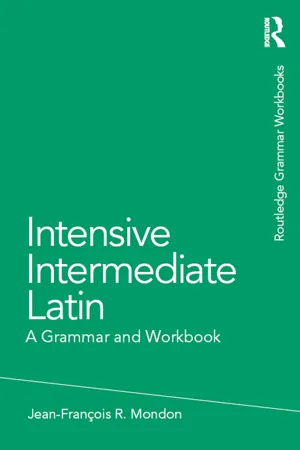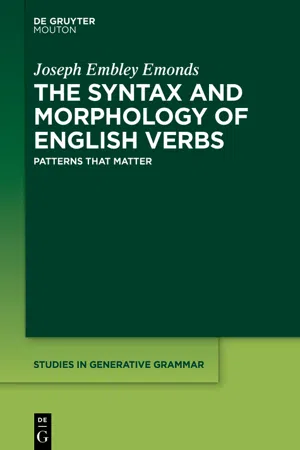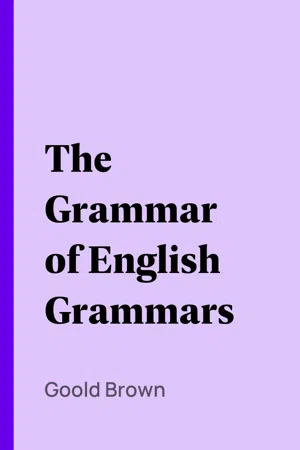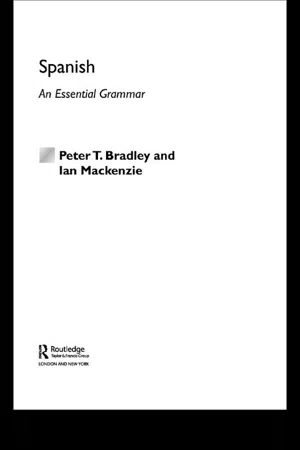Gerunds
Gerunds are verb forms that function as nouns, ending in -ing. They are used to express actions or states as subjects, objects, or complements in a sentence. In English, gerunds are commonly used after prepositions and as the subject of a sentence, and they can also be modified by adverbs or adjectives.
7 Key excerpts on "Gerunds"
- eBook - ePub
Introducing English Syntax
A Basic Guide for Students of English
- Peter Fenn, Götz Schwab(Authors)
- 2017(Publication Date)
- Routledge(Publisher)
...p.161 8 Non-finite clauses in the complex sentence (II) The gerund 8.0 The gerund The gerund is an - ing -form. It refers to actions, and especially to activity fields, in much the same way as a noun does: (1) a. Jogging became her great passion. b. Jill hates shopping. c. Their favourite evening activity was reading. There is also a passive gerund with the - ing -form of be, plus the past participle of the full verb, e.g. Jenny likes being asked difficult questions. Gerunds are not only noun-like in meaning. They also fill the same sentence functions as noun phrases, as we can see from these examples: subject in (1)a., direct object in (1)b. and subject complement in (1)c. For this reason, the gerund is traditionally called a ‘nominal’ verb form. Modern linguists, though, tend to regard this view as an oversimplification: the infinitive, after all, can take on the same functions, yet it is not seen as particularly ‘nominal’ in character. Secondly, like any other non-finite verb, the gerund always has a predicator function. It forms a subordinate clause even when it is alone, as in the sentences in (1). And this demonstrates its verbal character, underlined by the fact that within its own clause it can take its own verbal complementation: On the other hand, stressing the ‘nominal’ label does have a certain justification to it, particularly when the gerund is contrasted with the present participle. The latter is also an - ing -form, but as we will see later has no ‘nominal’ character at all syntactically. Secondly, even though infinitive clauses can also be noun-like, Gerunds are especially (and more or less exclusively) so...
- eBook - ePub
Intensive Intermediate Latin
A Grammar and Workbook
- Jean-Francois Mondon(Author)
- 2015(Publication Date)
- Routledge(Publisher)
...UNIT 28 Gerunds Background Verbal roots can form nouns, functioning in the different roles that nouns do: subject, object, object of preposition. • Such verbal nouns are Gerunds. • English forms Gerunds by suffixing - ing to the verbal root. ○ Observe that English Gerunds are identical in form to participles (Unit 33 of IBL) which also end in - ing. Running is a healthy activity. [subject] I like running. [direct object] He lost weight by running. [object of preposition] Present infinitives can also serve as verbal nouns, though they are limited to subject and object roles: To run is a healthy activity. [subject] I like to run every afternoon. [direct object] Being verbal, Gerunds can take objects [first two examples below] and also be modified by adverbial phrases [third example] just like verbs: I enjoy preparing dinner. He lost weight by eating healthy foods. I. like running often. Latin structure The gerund is formed by: • dropping -re from the 2 nd principal part amāre → amā- to love docēre → docē- to teach vincere → vince- to conquer capere (capiō) → cape- to seize audīre → audī- to hear • shortening the final vowel in the 1 st and 2 nd conjugations, while converting the 3 rd - iō and 4 th conjugations’ final vowels to -ie- : amā- → ama- docē- → doce- vince- → vince- cape- → capie- audī- → audie- • adding the. affix -ndum : ama- → amandum loving doce- → docendum teaching vince- → vincendum conquering capie- → capiendum seizing audie- → audiendum hearing Since the gerund is a noun it is declined. It follows the 2 nd declension neuter singular: Nom. – Gen. amandī Dat. amandō Acc. amandum Abl. amandō • Only two of the seven irregular verbs of Latin possess Gerunds: īre to go → eundum ferre to carry → ferendum • Note that the gerund does not form a nominative...
- eBook - ePub
- David Kilby(Author)
- 2019(Publication Date)
- Routledge(Publisher)
...Chapter Eight Ing There are at least three distinct forms in English which involve adding the suffix -ing to a verb stem - the participle, the gerund and the action nominal. Participles (which we shall not be further concerned with except insofar as they may be confused with Gerunds) are adjectival forms of the verb, and, like adjectives, they occur after the verb be (the progressive aspect) and before and after nouns (exhibiting some of the same variation as shown by passive participles in this respect - cf. chapter 5.): 1. John is mending his bicycle The crying baby had fallen down The baby crying had fallen down The gerund and the action nominal are both ways of nominalising sentences (using the term 'nominalise' in its broad - and not necessarily transformational - sense). However, gerundive constructions have many more of the properties of sentences than action nominals, and many fewer of the properties of nouns. The 'subject' of an action nominal, for instance, is always possessive, while the subject of a gerund may or may not be (and if it is not, it occurs in the 'oblique' case if it is a pronoun): 2. John's mending of the bicycle was inept *John mending of the bicycle was inept 3. John's mending the bicycle is odd John mending the bicyle is odd Him mending the bicycle is odd As can be seen from (2), the 'object' of the action nominal always occurs with the preposition of, while the 'object' of the gerund occurs in the same form as it would in the corresponding sentence...
- eBook - ePub
The Syntax and Morphology of English Verbs
Patterns that Matter
- Joseph Embley Emonds(Author)
- 2022(Publication Date)
- De Gruyter Mouton(Publisher)
...In both derived nouns and adjectives –ing can be an irregular, item-particular means of forming open class result Ns and fully lexicalized As from Vs, and additionally a productive default way to form Complex Event Nominals and Ongoing Action Adjectives. In these four derivational uses, the category N or A of the suffix plays a role as a head, as expected, in determining both the constructions’ distributions and in licensing their modifiers. 4.3.3 Productive uses of – ing as inflectional morphology In contrast to its just discussed roles in derivational morphology, the inflectional use of - ing in Gerunds and participles, exemplified in (4-2), has a more limited effect on the syntax of these mainly verbal constructions. As this chapter and the next show, –ing in NP Gerunds determines only that their basic distribution is nominal, and similarly that V -ing participles occur where APs do. Otherwise, the –ing in these consructions does not play the role of a selecting or selected head for material inside the NPs and APs where they occur. The patterns of modifiers within participles and Gerunds reproduce instead what is expected of heads that are Vs. As established in Chomsky (1970) for Gerunds and in Emonds (1985 : ch. 2) for participles, the forms of underlined internal modifiers in (4-33)-(4-34) all require that the head of the bracketed phrases be V, rather than N or A. 21 (4-33) Gerunds: Mary considered [ never spontaneously buying her son a shirt again ]. (4-34) Participle: Companies [ having opened us up new markets ] will be rewarded. The category of the suffix –ing in Gerunds like (4-2a)/ (4-33) and participles like (4-2b)/ (4-34) plays no role in licensing internal constituents, and also fails to be interpreted as an N or A. In these constructions, therefore, this N/ A suffix must carry the LF Cancellation Feature Ø (the feature introduced in chapter 1 for Stative Verbs V Ø and Realis Mood I Ø)...
- eBook - ePub
- Goold Brown(Author)
- 2004(Publication Date)
- Perlego(Publisher)
...21.—The Latin gerund is "a kind of verbal noun, partaking of the nature of a participle."— Webster's Dict. "A gerund is a participial noun, of the neuter gender, and singular-number, declinable like a substantive, having no vocative, construed like a substantive, and governing the case of its verb."— Grant's Lat. Gram., p. 70. In the Latin gerund thus defined, there is an appearance of ancient classical authority for that "amphibious species" of words of which so much notice has already been taken. Our participle in ing, when governed by a preposition, undoubtedly corresponds very nearly, both in sense and construction, to this Latin gerund; the principal difference being, that the one is declined, like a noun, and the other is not. The analogy, however, is but lamely maintained, when we come to those irregular constructions in which the participle is made a half-noun in English. It is true, the gerund of the nominative case may be made the subject of a verb in Latin; but we do not translate it by the English participle, but rather by the infinitive, or still oftener by the verb with the auxiliary must : as, " Vivendum est mihi rectè, I must live well."— Grant's L. Gram., p. 232. This is better English than the nearer version, "Living correctly is necessary for me;" and the exact imitation, "Living is to me correctly," is nonsense. Nor does the Latin gerund often govern the genitive like a noun, or ever stand as the direct object of a transitive verb, except in some few doubtful instances about which the grammarians dispute. For, in fact, to explain this species of words, has puzzled the Latin grammarians about as much as the English; though the former do not appear to have fallen into those palpable self-contradictions which embarrass the instructions of the latter. OBS. 22.—Dr...
- eBook - ePub
A Modern English Grammar on Historical Principles
Volume 5, Syntax (fourth volume)
- Otto Jespersen(Author)
- 2013(Publication Date)
- Routledge(Publisher)
...Chapter IX The Gerund. Verbal Nature In this chapter we deal with those points in which the syntax of the gerund has approached that of finite verbs. Tertiaries with Gerunds On those combinations in which an adverb (tertiary) enters as first part into a compound with a gerund as second part, see 8.6 2. 9.1 1. A gerund combined with a following adverb that supplements the verbal idea. This begins in the 14th c.: Ayenbite 263 ate uerste guoinge in (many quotations in Blume) | Mandv 282 at oure goynge out | Ch MP 10.11 thy [fortune's] whirling up and doun | id H 67 in liftinge up his hevy dronken cors | Caxton R 95 without goyng in to the myre | Gosson Seh. of Abuse 23 Marius giueth an account of his bringing vp | Marlowe E 859 thy parting hence | Sh Lr V. 2.10 Men must endure Their going hence, euen as their comming hither | Cymb II. 4.23 worthy his frowning at | Gent IV. 3.29 my flying hence | R2 III. 3.112 His coming hither | AV Ps 139.2 Thou knowest my downe sitting, and mine vprising... 3 my lying downe | ib Hebr 10.27 a certaine fearefull looking for of iudgement | Ruskin T 17 you think such matters need debating about? | Mrs Carlyle in Carlyle F 3.184 getting what waiting on I absolutely needed | Twain H 1.28 I got a good going-over from Miss Watson, on account of my clothes | Ridge G 100 I gave your father a straight talking to | Pinero S 105 it's my duty, as an old friend, to give you a good talking-to | Shaw Ibsen 5 the explanation will not be an explaining away | Caine C 151 they went on with their making-up. 9.1 2. Examples of the plural of such Gerunds: AV Job 7.4 I am full of tossings to and fro | Bunyan P 79 he heard rushings to and fro | id G 4 my castings down, and risings up. 9.1 3. The gerund and adverb may in rare cases be separated by an object: Defoe Rox 182 any of the people that had the breeding of them [children] up. 9.1 4...
- eBook - ePub
- Peter T Bradley, Ian Mackenzie(Authors)
- 2004(Publication Date)
- Routledge(Publisher)
...Chapter 18 Uses of the gerund Spanish Gerunds are invariable and always end in -ndo (for full details of forms, see 10.8). Broadly speaking the Spanish gerund conveys the idea of ‘in doing’, ‘while doing’ or ‘by doing’. Students should note that English nouns and adjectives ending in ‘-ing’ normally are not translated by a Spanish gerund (see 18.5). The gerund is also used in combination with estar to form the progressive tenses (see 10.10). 18.1 Basic use of the gerund The basic effect of the gerund is to indicate that the action it refers to occurs at the same time (more or less) as the action described by the main verb: Antonio contestó sonriendo. Antonio smiled as he replied. Lo esperé leyendo el periódico. While I waited for him I read the paper. As an extension of this usage, the gerund can indicate method, cause or purpose. It may correspond to ‘by’ + gerund, ‘as/since’ + clause, or ‘to’ + infinitive: Ganaron haciendo trampas. They won by cheating. Llamándola por teléfono la vas a espantar. You’ll frighten her off by phoning her. Estando en Granada tienes que visitar la Alhambra. As you are in Granada you have to visit the Alhambra. Me gritaron pidiendo ayuda. They shouted to ask for help. Note : If the word como is inserted before the gerund, the simultaneous action becomes imaginary rather than real, similar to como si ‘as if’+ subjunctive: Movió la cabeza como diciendo no ‘He shook his head as if saying no’. 18.2 Gerund and main verb with different subjects In the examples above, the subject of the gerund is also the subject of the main verb. For example, Antonio in Antonio contestó sonriendo is the subject of both contestar and sonreír. However, the gerund and the main verb can have different subjects...






